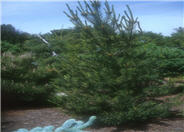
Common name:Limber Pine
Botanical name:Pinus flexilis
Limber pine is a high-elevation Utah native that gets its common name from its flexible branches that bend under the weight of snow rather than breaking. It has an upright, rounded pyramidal form, and grows about 25 to 35 feet tall and wide. It has stiff needles that curve upwards and green cones that ripen to brown. Its width makes it tough to use in an urban setting, but there are several cultivars in trade that are well suited to city-scapes, including 'Vanderwolf's Pyramid.' There are some limber pines in the Greater Avenues Water Conservation Demonstration Garden.
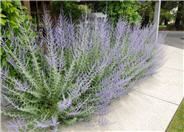
Common name:Russian Sage
Botanical name:Perovskia atriplicifolia
Russian sage may be the ubiquitous low-water garden plant. With its grey green, aromatic foliage, and azure blue spires, it provides a long-lasting show in hot, dry gardens. It grows to 3 to 5 feet tall, and nearly as wide. It is a woody perennial and forms a very hard trunk over time. It is both airy and substantial, and partners well with herbaceous perennials, woody shrubs, or ornamental grasses. It also would grow well against a south or west facing wall or fence.
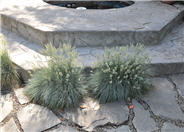
Common name:Elijah Blue Fescue
Botanical name:Festuca cinerea 'Elijah Blue'
The icy-blue coloration of this little grass makes it a stand-out in the garden. Its evergreen, clumping habit make it well suited for edging borders, mass planting, or ground cover. Grows in full sun to part shade. Generally under 12 inches, even in flower. Soft tufts of greenish white flowers emerge in early summer and turn tawny by summers end. Excellent for parkstrips.
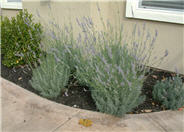
Common name:Provence French Lavender
Botanical name:Lavandula x intermedia 'Provence'
Provence is one of the lavenders grown commercially in France. 30 to 36 inches tall and 24 to 30 inches wide, it produces long stems of pale lavender flowers prized for their fragrance and flavor. Gray-green foliage is also pleasantly aromatic. Grows in full sun and well drained soil. This lavender gets big, so plant it where it will have the space it needs. It is also woodier than other lavender.

Common name:Boston Ivy
Botanical name:Parthenocissus tricuspidata
This semi-evergreen vine has dark green leaves that are usually lobed and divided into 3 leaflets. Clings with both tendrils and adhesive-like tips that cements itself to all manner of surfaces. Leaves turn orange or red in autumn. Flowers are inconspicuous. During fall, small blue black berries appear to the delight of birds. This vine can grow 50'-60' long but it really depends on what it is growing on. This vine is aggressive.
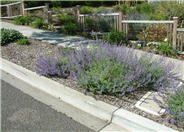
Common name:Catmint
Botanical name:Nepeta x faassenii
Catmint makes soft, grey-green, rounded mounds from 10 to 24 inches high, depending on variety. Most will be wider than tall. This perennial has lavender blue flowers from late spring to early summer, though if you shear off the first flowers, it will frequently bloom again later in the summer. Different varieties have slightly different bloom times. Leaves are attractive, crinkled blue-grey and are aromatic.
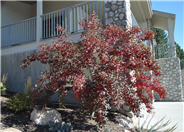
Common name:Purpleleaf Sandcherry
Botanical name:Prunus x cistena
Purpleleaf sandcherry is a deciduous shrub valued for its reddish-purple foliage, fragrant white and pink spring flowers, and purple-black fruit. It grows about 7 to 10 feet tall and 5 to 8 feet wide, with an upright, vase shape. It is sometimes sold as a single-stem tree, but will require maintenance to maintain this form. Bark is a dark brown to red, and is a nice contrast in the winter garden. Branches are nice in vases.

Common name:Limber Pine
Botanical name:Pinus flexilis
Limber pine is a high-elevation Utah native that gets its common name from its flexible branches that bend under the weight of snow rather than breaking. It has an upright, rounded pyramidal form, and grows about 25 to 35 feet tall and wide. It has stiff needles that curve upwards and green cones that ripen to brown. Its width makes it tough to use in an urban setting, but there are several cultivars in trade that are well suited to city-scapes, including 'Vanderwolf's Pyramid.' There are some limber pines in the Greater Avenues Water Conservation Demonstration Garden.
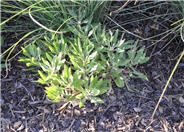
Common name:Missouri Evening Primrose
Botanical name:Oenothera macrocarpa
Missouri evening primrose is a sprawling perennial that typically grows 6 to 12 inches tall and 12 to 18 inches across, though through reseeding, it can spread farther. It has singe, 4-petaled, mildly fragrant, bright yellow flowers which open for only one day (usually open late afternoon and remain open until the following morning). Flowers are generally upward-facing, but sometimes rest on or touch the ground. Long spring to summer bloom period. Flowers are followed by somewhat unique, winged seed pods. Narrow, lance-shaped leaves. Stems are sometimes a vivid crimson red. Grow in rock gardens, perennial borders, parkstrips, and evening gardens. Many cultivars available.
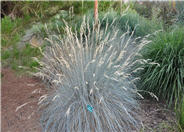
Common name:Blue Oat Grass
Botanical name:Helictotrichon sempervirens
Blue oat grass is a striking ornamental grass with blue foliage and a clumping habit. It grows 12 to 18 inches tall and wide. Its showy flowers are 1 to 2 feet above the foliage. Is evergreen in mild winters. This plant looks good alone as well as in mass plantings. The blue oat grass likes dry hill sides and is drought tolerant.
| Designer: | Misc 22 |
Photographer: GardenSoft |
Water Saving Tip:
Even though it's hot, your lawn only needs to be watered twice a week to stay healthy.
And don't water the whole lawn for a brown spot—drag out a hose.
